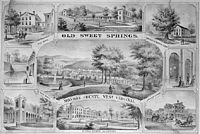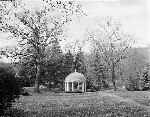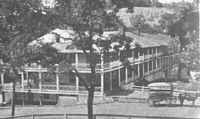Resort Springs
 Our subject makes an abrupt and disconcerting shift at this
point from urban centers and public transportation, to rural
Virginia/West Virginia and the topic of water. Clumsy as the
transition is, I hope that by story's end it may seem justified.
Today, when half the population of the world seems to be holding
a small plastic bottle of purchased "spring" water, some of the
very best of it originates in Monroe County, West Virginia.
The water bottled and marketed from the springs of Monroe County
is world-famous and award-winning for its quality, purity, and
taste. The water of the Sweet Springs Valley Water Company from
the springs on Peter's Mountain was the gold medal winner in 1991,
1993, 1995, and 1997 at the Berkeley Springs International Water
Tasting. In the 19th century the story was slightly different,
though then as now the area was noted for both its climate and
its springs. The tidewater's oppressive summer heat (pre-air
conditioning) made the mountain air irresistible to people near
the coast, and the springs, which were numerous, were reputed
to be beneficial to health. And earlier still, Thomas Jefferson
in his 1787 Notes on the State of Virginia (p.32) chose
his words carefully: "There are several Medicinal springs, some
of which are indubitably efficacious, while others seem to owe
their reputation as much to fancy, and change of air and regimen,
as to their real virtues. None of them having undergone a
chemical analysis in skilful hands . . . , it is in my power
to give little more than an enumeration of them." White Sulphur,
Salt Sulphur, Hot and Warm and Healing, Blue, Grey, and Red —
the list was long. The earliest of all, discovered in 1764, was
Sweet Springs in eastern Monroe county. Only a mile away was
the Red Sweet, also known as the Sweet Chalybeate.
Our subject makes an abrupt and disconcerting shift at this
point from urban centers and public transportation, to rural
Virginia/West Virginia and the topic of water. Clumsy as the
transition is, I hope that by story's end it may seem justified.
Today, when half the population of the world seems to be holding
a small plastic bottle of purchased "spring" water, some of the
very best of it originates in Monroe County, West Virginia.
The water bottled and marketed from the springs of Monroe County
is world-famous and award-winning for its quality, purity, and
taste. The water of the Sweet Springs Valley Water Company from
the springs on Peter's Mountain was the gold medal winner in 1991,
1993, 1995, and 1997 at the Berkeley Springs International Water
Tasting. In the 19th century the story was slightly different,
though then as now the area was noted for both its climate and
its springs. The tidewater's oppressive summer heat (pre-air
conditioning) made the mountain air irresistible to people near
the coast, and the springs, which were numerous, were reputed
to be beneficial to health. And earlier still, Thomas Jefferson
in his 1787 Notes on the State of Virginia (p.32) chose
his words carefully: "There are several Medicinal springs, some
of which are indubitably efficacious, while others seem to owe
their reputation as much to fancy, and change of air and regimen,
as to their real virtues. None of them having undergone a
chemical analysis in skilful hands . . . , it is in my power
to give little more than an enumeration of them." White Sulphur,
Salt Sulphur, Hot and Warm and Healing, Blue, Grey, and Red —
the list was long. The earliest of all, discovered in 1764, was
Sweet Springs in eastern Monroe county. Only a mile away was
the Red Sweet, also known as the Sweet Chalybeate.
Most Monroe countians today know of someone who has drilled
for water only to find with it a strong sulphur odor or a
high iron content. Those with iron in their water can boast
of having a chalybeate spring of their very own, for "containing
iron" is the meaning of the term. Nowadays we employ devices to
improve the taste of such water. In the 19th century the
putative medicinal virtues of these springs often proved the basis
for successful economic ventures.
 Although today White Sulphur Springs has won the economic contest,
Monroe's Sweet Springs for some years rivaled it. The brothers Thomas
and William Lewis and other members of their family long worked to
promote it. Both it and the neighboring Sweet Chalybeate Springs
were incorporated in 1836 as health resorts. These were exactly
the years during which in New York young John Stephenson was
initiating his own business that would before long supply these
resorts with our omnibus. White Sulphur was not incorporated
until 1845. Incidentally, one today can still taste White
Sulphur's water, in a paper cup from a dispenser under the
pillar-supported dome that protects the location where the
famous water is freely available to those who dare. The spring,
frequented less often than in the 19th century, is of course on
the grounds of The Greenbrier. The taste is not good. And
it lingers. And lingers.
Although today White Sulphur Springs has won the economic contest,
Monroe's Sweet Springs for some years rivaled it. The brothers Thomas
and William Lewis and other members of their family long worked to
promote it. Both it and the neighboring Sweet Chalybeate Springs
were incorporated in 1836 as health resorts. These were exactly
the years during which in New York young John Stephenson was
initiating his own business that would before long supply these
resorts with our omnibus. White Sulphur was not incorporated
until 1845. Incidentally, one today can still taste White
Sulphur's water, in a paper cup from a dispenser under the
pillar-supported dome that protects the location where the
famous water is freely available to those who dare. The spring,
frequented less often than in the 19th century, is of course on
the grounds of The Greenbrier. The taste is not good. And
it lingers. And lingers.
Sweet Springs, as all Monrovians know, long prospered. Oren F. Morton, in his 1916 A History of Monroe County (pp. 205-206), still available at the Historical Society museum in a modern reprint, tells us that George Washington stayed there in 1797, and that Presidents Pierce and Fillmore visited as guests. As for the water? Morton says: "the waters of the mineral spring . . . are mildly alterative and cathartic, and are serviceable in ailments of the digestive organs and in debility. They are thermal, having a temperature of 73 degrees, or some 20 degrees above the mean atmospheric temperature of the locality. Their properties are similar to those of the famous hot wells of Bristol in England." Other authors, particularly those of the 19th century, showed far less restraint than Morton when listing the multitudinous diseases and the intimate anatomical organs and bodily functions affected by the waters from Monroe County's springs.
The physical settings of Monroe's many springs offered a more
family friendly topic. The artist Edward Beyer, who visited
most of them, creating a painting for each, gave brief and
invariably favorable descriptions of their features. Of
Salt Sulphur: "This beautiful Watering Place . . . is hemmed
in on every side by mountains. . . . The pleasure walks on
the heights surrounding the Springs give visitors an opportunity
to gaze on the romantic and grand in Nature, while a pathway
through the meadow and along the shaded banks of Indian Creek,
present not so bold but not less attractive scenery." (VMFA credit)
And always, as we have seen, access was available by horse-drawn
vehicles.
 Charles B. Motley,in his Gleanings of Monroe County West
Virginia History (Danville, Va., 1973, p.129), preserves
this photo of "Indian Creek, Red Sulphur Springs, W. Va., showing
method of conveying passengers to the Springs in olden times."
The vehicle in this photo is not an omnibus, but as usual the
vehicle appears to be overloaded. The Red Sulphur Spring some
40 miles to the west of Sweet Springs, should not be confused
with the Red Sweet, or Sweet Chalybeate, which figures largely
in connection with our omnibus.
Charles B. Motley,in his Gleanings of Monroe County West
Virginia History (Danville, Va., 1973, p.129), preserves
this photo of "Indian Creek, Red Sulphur Springs, W. Va., showing
method of conveying passengers to the Springs in olden times."
The vehicle in this photo is not an omnibus, but as usual the
vehicle appears to be overloaded. The Red Sulphur Spring some
40 miles to the west of Sweet Springs, should not be confused
with the Red Sweet, or Sweet Chalybeate, which figures largely
in connection with our omnibus.
 Edward King (1848-1896), in his work The Great South,
says that the baths at Sweet Springs "are frequented from dawn
until dusk by crowds who represent the best talent of the West
and South," and also says, "The Red Sweet Spring, situated but
one mile from the Old Sweet, is one of the prettiest retreats
in the mountains. The chalybeate and tonic water annually draw
hundreds of visitors to them." Edward Beyer testifies to the
friendly interchange between the two neighboring resorts.
"There has always been union and harmony between the Old and
Red Sweet. Their interests to some extent have been blended;
and visitors during the season are continually passing from
one to the other." (VMFA credit) Those visitors were
transported in our own John Stephenson omnibus, which still
bears the Chalybeate Spring name, and can be seen, I believe,
standing ready in this old photo of the Chalybeate resort.
Edward King (1848-1896), in his work The Great South,
says that the baths at Sweet Springs "are frequented from dawn
until dusk by crowds who represent the best talent of the West
and South," and also says, "The Red Sweet Spring, situated but
one mile from the Old Sweet, is one of the prettiest retreats
in the mountains. The chalybeate and tonic water annually draw
hundreds of visitors to them." Edward Beyer testifies to the
friendly interchange between the two neighboring resorts.
"There has always been union and harmony between the Old and
Red Sweet. Their interests to some extent have been blended;
and visitors during the season are continually passing from
one to the other." (VMFA credit) Those visitors were
transported in our own John Stephenson omnibus, which still
bears the Chalybeate Spring name, and can be seen, I believe,
standing ready in this old photo of the Chalybeate resort.

